Needles are inserted above or between the eyes, at the back of the head, and behind the left and right ears. Next, a tube with a sponge cap is inserted into the animal's ears, through which sounds of a certain intensity are delivered, produced as clicks and crackles, and which reach the ear canal. This examination can detect both complete and partial deafness, including unilateral deafness.
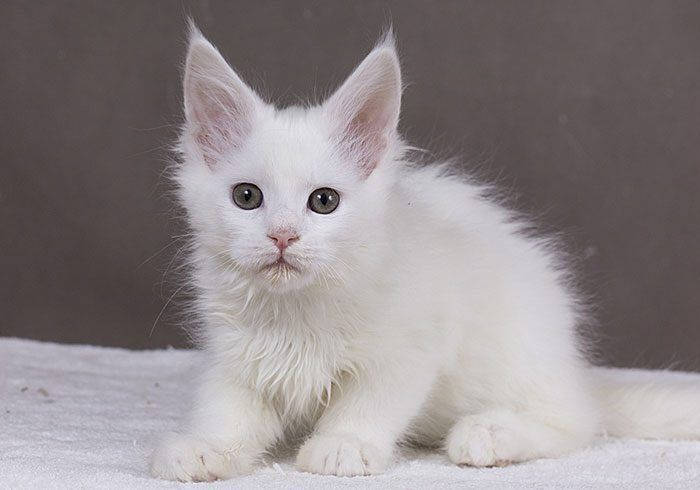
- Are white cats deaf? I tell you why it happens and how to live with it.
- A Little Science – Are all white cats deaf?
- No need to be afraid.
- Gene Mutation Test
- How do I know if my white cat can't hear anything?
- How to deal with white and deaf cats?
- The genetics of deafness in cats
- Factors increasing the probability of deafness in white cats
- Types of deafness in cats
- Conductive deafness
- Neurosensory deafness
- Diagnosis of deafness in cats
- White Cat Deafness
- The genetics of white coloration in cats
- Color and deafness
- Cats with white coloring
- Kao Mani .
- Foren-White .
- Do not be afraid.
- If the pet is deaf
Are white cats deaf? I tell you why it happens and how to live with it.
Cats with snow-white hair, without a drop of other color, are uniquely beautiful and ornate. Unfortunately, white hair often comes along with increased sensitivity to UV rays, increased eye sensitivity and unfortunately with. deafness.
White cats have a dominant gene responsible for the white coat color (more accurately responsible for the lack of color. ), and that's the W gene. related also with hereditary deafness . This defect occurs most often in white cats with blue eyes.
A Little Science – Are all white cats deaf?
Fortunately. not every white cat even with blue eyes, is susceptible to hereditary deafness !
However, most exactly white cats with blue eyes suffer from congenital deafness ! Why is this so?
The explanation is as follows. 👉 The white gene, W, suppresses the production of melanocytes – the cells responsible for pigmentation throughout the body. As a result, when the gene inhibits the migration of pigment-producing cells in the hair, the cat is born with white hair.
And if dye production in the iris is blocked, the eyes are not discolored, but become a blue hue!
🦻Melanocytes line the inside of the cochlea to maintain the ionic balance between the hair cells of the inner ear. This is necessary in order to, so that the sound waves that reach the cochlea, were converted into electrical impulses …which are then… which are then sent to the brain. .
If there is no melanocyte layer, this process is disrupted. The cochlear ducts degenerate and the hair cells die off – as a result Degeneration of the hearing organs occurs so rapidly that kittens with this defect, even at an early age, cannot hear!
No need to be afraid.
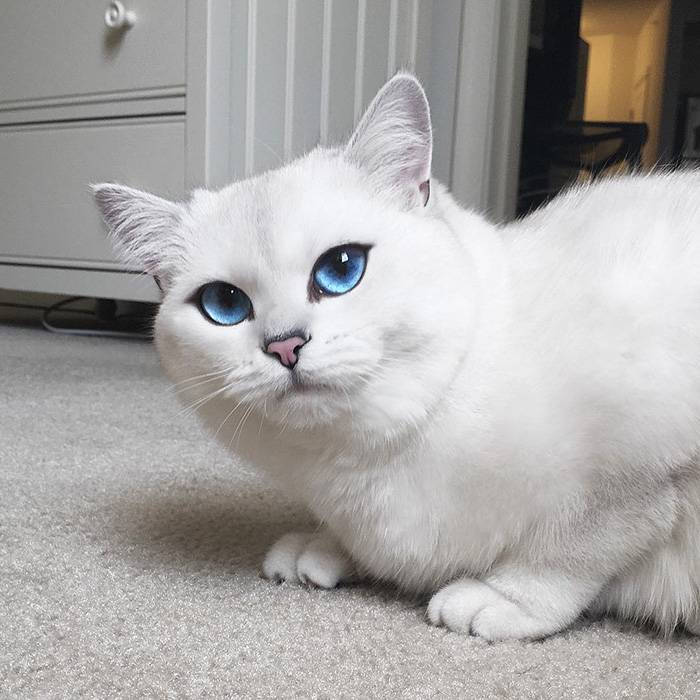
But you shouldn't be so afraid! The risk is actually not that big. According to statistics 18-20% of white cats without blue eyes are still born deaf, no one is safe from this! Cats with different color eyes (heterochromia), if one of their eyes is blue, are born deaf in 40% of cases, most often deafness occurs in the ear, on the side of which is located blue eye. But white cats, who have blue eyes in addition to the blue color of both eyes, as it would be sad, are deaf from birth in 80% of cases.
Gene Mutation Test
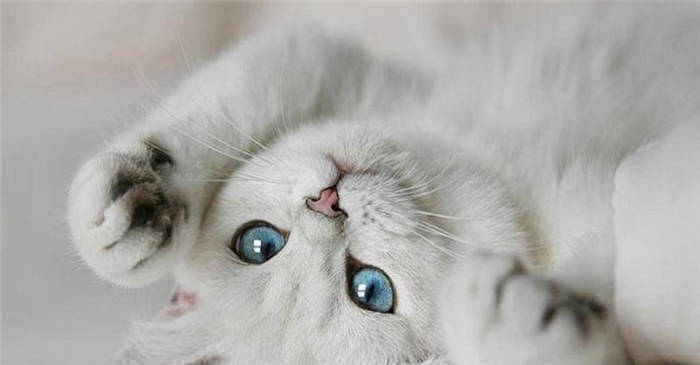
To test for deafness or the deafness gene, a so-called BAER test is performed. In the vast majority of cases, it gives accurate and truthful results. Deafness most often affects only one hearing organ, so it is very difficult to notice it at home. But if the cat is at risk, the best option is to have the fluffy cat tested so that his offspring don't inherit the gene.
How do I know if my white cat can't hear anything?
If your cat is not deaf from birth, the definition of deafness is very simple: the pet will become less responsive to your speech, and will stop reacting to the sounds of a rustling bag of food, toys, and other things.
But if you suspect this, you should take the cat to the vet. He will do some simple hearing tests and possibly a couple of tests. This way you will get reliable information about your cat's hearing health, and you will also understand the cause of possible problems (because deafness can be a consequence of more than just genetic reactions).
How to deal with white and deaf cats?
Obviously, deaf cats need more care from their owner. You can highlight a couple of simple but effective tips that will be useful to you:
- It's important to communicate with your cat with repetitive gestures that she will eventually be able to recognize.
- Your facial expression also plays a key role. Make sure that you maintain the same facial expression when you want to communicate the same thing. That way your pet will know exactly what you are saying to him at that moment.
The genetics of deafness in cats
Scientists have studied and explained quite well the reason for the increased number of cases of deafness specifically among white cats. It is all about the insidious mutant gene Dominant White (W-).
During the developmental stage of the embryo, a certain number of melanoblasts begin to form near the neural tube to produce pigment and distribute it to the hair follicles and retina. With normal genetic development, delivery occurs in time, and colorful kittens with green or yellow eyes are born. But as soon as a mutant appears in the blood, everything changes. It severely slows down the speed of the melanoblasts. They don't arrive to the skin in time to fill the follicles. It's the same with the retina. It turns out that the pigment does not get into them. Sometimes, a small number of melanoblasts do reach their targets, so only certain areas of the body may be white. Or the pigment gets to the iris only in limited amounts, so the kitten is born heterochromatic, when one eye is blue, and the other, for example, yellow. This phenomenon occurs not only among cats, but also among other animals and even humans.
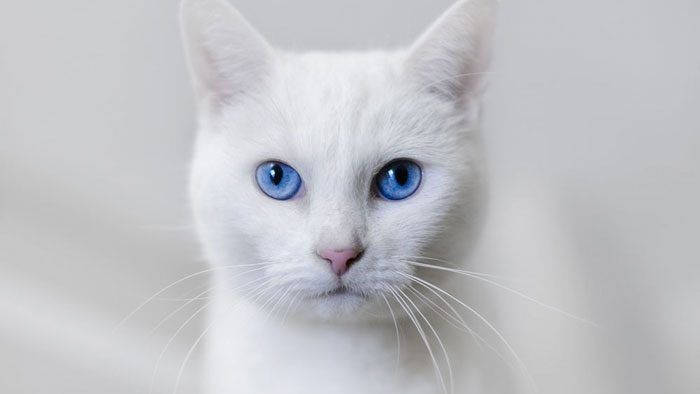
Other cells are formed near the neural tube, which, in particular, are responsible for the normal development of the auditory system. The mutant inhibits their proliferation as well. It has been found that a single dominant allele of the W gene can affect not only hair and eye color, but also provoke deafness. The right groups of cells go to the middle ear when it is already misshapen and nothing can be corrected.
The effect of the gene continues to be studied because it turns out that kittens with white hair and congenital ear defect have several other deviations from the norm: they are less fertile and vitality is reduced. It turns out that the mutant affects almost all processes during the formation of the fetus, rather than being responsible for only one trait – the presence of pigment.
Factors increasing the probability of deafness in white cats
The figure shows how likely a cat is to be deaf, depending on the color of its coat and iris. Auditory defects can affect two ears, or they can occur in only one.
Among the entire cat population, there are no more than 1.5% who have white coats and blue eyes, one or both. Their geographic prevalence is uneven.
Studies have found that white cats with long coats are more likely to have hearing defects than their short-haired counterparts. In addition, blue-eyed cats are 5 times more likely to have middle ear degeneration than animals with other colored eyes. Having only one blue eye increases the risk of developing deafness twice as much as cats with both eyes that are not blue.
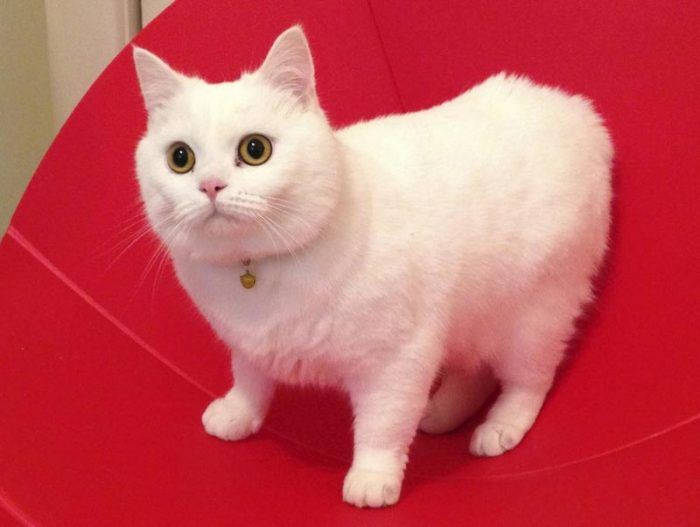
As a result of natural selection, cats with white hair have virtually no chance of surviving in the wild for several reasons:
But people liked white cats so much that today the requests for such kittens are very high. This type of color occurs in almost every breed, and breeders have learned to test a cat for deafness with a BAER test, which can be done at any veterinary clinic. If suddenly the defect is found, such a cat will not participate in further continuation of the breed.
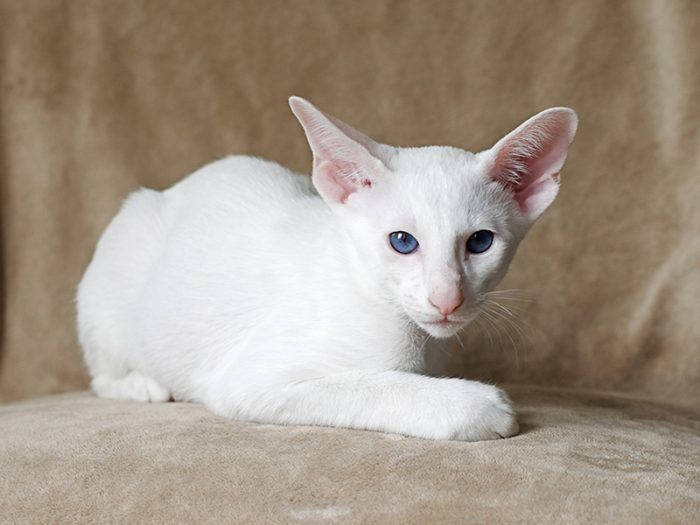
Types of deafness in cats
Conductive deafness
Concludes in difficulty in the passage of sound in the middle or outer ear, hence the name – conductive. Most often it is caused by diseases or infections that lead to fluid accumulation inside the ear, damage to the eardrum and occlusion of the ear canals. In this case, hearing is only partially lost. With the right treatment, it can be restored with medication or surgery.
Neurosensory deafness
Often this deafness is apparent from birth and begins to develop as early as the embryonic stage. It is completely untreatable. Serious disorders of the inner ear are involved. Most often, sensorineural deafness is complete, its partial manifestations are very rare. It may also occur in adult cats as a result of age-related destruction.
Diagnosis of deafness in cats
The ears have a rather complex structure, only the coordinated work of the eardrum, middle and inner ear helps the animal to hear well. If there is a problem at any of these stages, hearing is lost. This phenomenon is often seen in older cats due to age-related changes.
Deaf cats are also called "perpetually asleep" because even the loudest sounds that cause a healthy cat to react cannot wake them up. Usually normal cats react to the appearance of a person in advance, especially if he does not tiptoe, but just walk at a normal pace.
You can check how close you need to get for the animal to hear you. You need to take several measurements to find out the exact distance from which the pussy begins to hear, as it may be different each time depending on the phase of sleep. The average is taken as the truth.
Another sure way to determine if a pussy is deaf is to call out to the animal from another room. If the pussy cat is unresponsive to the voice, there is a possibility of diminished hearing function. True, some cats may deliberately ignore you to demonstrate once again who's boss in the house.
Only a veterinarian can make a definitive diagnosis of total deafness. A specially developed BAER (Brainstem Auditory) test can do this. The procedure is painless for the animal, the main thing is to hold the cat and allow the doctor to attach a special clip with electrodes to the ear. Each ear is examined separately, for this purpose the second earpiece or a foam insert is plugged. Then an acoustic noise is made and the reaction of the brain is checked. A well hearing cat will have impulses in the brain in response to the sound and this will be reflected on the monitor. With deafness, the brain does not respond to noise, so no impulses will appear.
Deafness is not a reason to give up a pet. Such pets get along very well with their owners and even interact with them, but the reaction is no longer to their voice but to their gestures or facial expressions. The owners of these cats learn to make eye contact with them, so people and animals get along well and understand each other without words.
White Cat Deafness
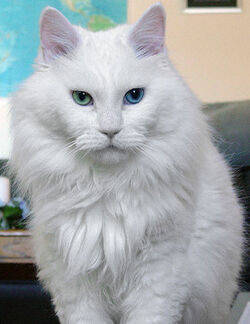
Some white cats suffer from hearing loss caused by degeneration of the inner ear. This condition is often accompanied by a blue iris. Deafness can be in both ears or unilateral. White cats can have blue, yellow, green or orange eyes. It has been found that all-white cats with different colored eyes usually have deafness in the ear on the blue eye side.
In a 1997 study, cats with varying degrees of hearing loss were examined. Seventy-two percent of the cats examined were deaf. It was found that the Corti organ degenerated completely within the first few weeks after birth. But even during those first weeks, auditory stimuli did not excite a response in the brainstem, suggesting that these animals never had any sound sensations. It was also found that a few months after degeneration of the cortical organ, the nerve cells of the cochlea of the inner ear began to degenerate.
The genetics of white coloration in cats
The genetic causes of deafness in white cats are fairly well understood. Deafness in white cats is caused by the influence of the dominant W- allele of the white coat color gene, which triggers certain processes occurring in the early stages of embryo development, when a group of specific cells, melanoblasts, are released in the neural tube area. The purpose of the melanoblasts is to produce pigment and transport it into each hair of the cat's coat. However, hair does not grow around the neural tube, but on the skin. Therefore, melanoblasts, in order to dock with the hair

and follicles must make long migrations in the body of the embryo from the neural tube to the skin and retina, which are located at a considerable distance from the neural crest. Some melanoblasts overcome this distance and arrive at their destination exactly when the hair follicles and retina are already developed.
However, during domestication of the cat (as well as other pets) a dominant mutation arose which impairs the ability of these cells to migrate, the aforementioned Dominant White (W-) mutation. Since melanoblasts in cats homo- and heterozygous for this mutation do not reach the skin in time, they are unable to transfer the pigment into the hair, and the coat grows white. Sometimes they manage to penetrate into the hair follicles on the head of the cat, and then there are small colored areas. The number of melanoblasts that have reached the retina may be different in different carriers of this mutation. If there are a lot of them, the eyes have a normal yellow color, if very few – blue. It also happens that in one eye is a lot, and the other a little. In this case, you have a mongrel cat: one of his eyes is yellow, the other is blue. The phenomenon of divergence (complete heterochromia of the eyes (Heterochromia iridis), which occurs in some species of domestic animals as well as in humans, is now also quite well studied.
Color and deafness
Many white cats are deaf due to degeneration of the inner ear. Geneticists, studying these animals, have determined that their deafness depends on the color of their eyes:
In mismatched cats, it is usually the side of the blue eye that causes deafness.

The cause of deafness is in the dominant W gene. After much research scientists have determined that it is pleiotropic – responsible for a number of traits in the genotype – not only for coat color, but also for deafness and blue-eyedness. By the way, you can also read about blue-eyed cats and breeds on our portal.
The dominant W allele disrupts the migration of melanoblasts, pigment producers and transporters, and also affects the activity of other cells in the neural tube region of the embryo

Deaf cats are excluded from the breeding program. And as a pet they can live as absolutely full-fledged individuals, the lack of hearing is compensated by other sense organs. True, such animals will not survive on the street.
Cats with white coloring
Many breeds of cats come in white. But there are those for which this color is a distinctive feature.
Kao Mani .
This breed came into the world from Thailand. In Thai, it is translated as "white gemstone. In English-speaking countries it is often called "Diamond Eye. Snowy fur and heterochromia are distinctive features of these cats.
This ancient variety is mentioned in the manuscript "Book of Cat Poems." For many centuries, it could only be the pet of the royal household.
Kittens are often born with a dark spot on the head, which usually disappears with age. But sometimes there are individuals not pure white shade, spotty. Eyes can be different colors – amber, green, blue. Heterochromia is rare. About half of the animals suffer from hearing loss in one or both ears.
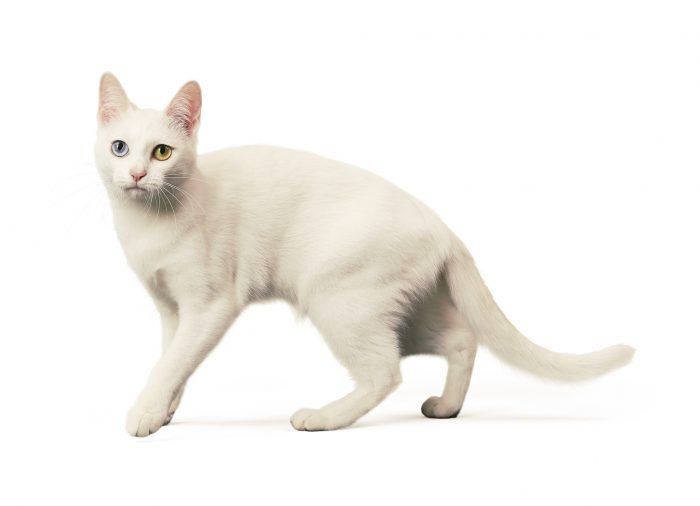
By nature, they are active, cheerful and energetic pets, love to "talk. Very trusting and good-natured, strongly attached to the owner. The price of a kitten is very high – £600-900. These animals are very rare.
Foren-White .
These cats of the purest white color are obtained by genetic selection and inbreeding of the common Siamese. The peculiarity of this breed is that with a snowy color and blue eyes, kittens are never born deaf.
Geneticists believe that this trait is due to the long isolation of the Siamese from other species, the purity of its line, because deafness first appeared, most likely, from the Angora.
In English, "forn-white" means "white foreigner." The breed was registered in 1966 in Great Britain. By character, these snowy pets are true Siamese. The cost of kittens from the cattery is 35-50 thousand rubles.

Do not be afraid.
But don't be so afraid! In fact, the risk is not so great. According to statistics 18-20% of snow-white cats without blue eyes are still born deaf, no one is safe from that! Cats with different color eyes (heterochromia), if one of their eyes is blue, are born deaf in 40% of cases, most often deafness occurs in the ear, on the side of which is located blue eye. But white cats, having in addition a blue color of both eyes, however it would be sad, are deaf from birth in 80% of cases.
To check for deafness or deafness gene, there is so-called BAER test. In the vast majority of cases, it gives accurate and truthful results. Deafness most often affects only one hearing organ, so it is very difficult to notice it at home. But if the cat is at risk, the best option is to test the furry so that his offspring don't inherit the gene.
If the pet is deaf
What to do if a cat is deaf? It is worth remembering that a cat, even if it is deprived of this important organ, is able to feel quite harmonious. Cats feel healthy and happy if the owner provides them with proper care.
One should always remember that a cat can get into an unpleasant or dangerous situation because of his illness. One should make sure that the cat is not confronted with situations where it needs to hear sound signals, otherwise it may be injured. A pet may not hear the sound of an approaching car or a stray dog barking, these situations simply should not be allowed!
Despite this, we must understand that the cat does not feel its injury and can not understand that it is special. This should be remembered by the owner, to give time to his white friend, to love him and pamper him in different ways, remembering that the pet is special, and therefore, the attitude should be appropriate!
Any cat, regardless of its sex, age, color, eye color, coat structure, breed, hereditary diseases can become a great friend for many years! Any cat, like any living creature, needs attention, care, and acceptance for what it is!






